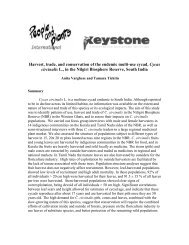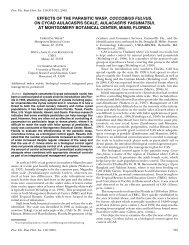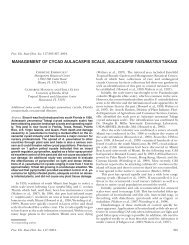Glossary of terms used in cycad systematics - Cycad Specialist Group
Glossary of terms used in cycad systematics - Cycad Specialist Group
Glossary of terms used in cycad systematics - Cycad Specialist Group
Create successful ePaper yourself
Turn your PDF publications into a flip-book with our unique Google optimized e-Paper software.
Walters & Osborne – <strong>Cycad</strong> Classification: Concepts & Recommendations, Appendix 2 5<br />
circ<strong>in</strong>ate. Rolled <strong>in</strong> a coil-like manner with the apex <strong>in</strong>nermost, as <strong>in</strong> leaflets <strong>of</strong> emerg<strong>in</strong>g leaves <strong>of</strong><br />
Cycas species, hence C. circ<strong>in</strong>alis. See also conduplicate, <strong>in</strong>flexed, ptyxis, reflexed, vernation.<br />
CITES. Convention on International Trade <strong>in</strong> Endangered Species, a United Nations treaty which sets<br />
out a conservation regulatory process between the signatory countries.<br />
clade. One particular monophyletic branch <strong>in</strong> a cladogram.<br />
cladistics. Method <strong>of</strong> classification that groups taxa hierarchically and parsimoniously <strong>in</strong>to nested sets<br />
accord<strong>in</strong>g to their synapomorphies; the output conventionally presented <strong>in</strong> the form <strong>of</strong> a cladogram.<br />
cladogram. Tree diagram based on parsimony analysis show<strong>in</strong>g taxa grouped hierarchically <strong>in</strong> nested<br />
sets accord<strong>in</strong>g to their synapomorphies. A cladogram has no connotation <strong>of</strong> ancestry and has no<br />
implied time axis. See also dendrogram, phenogram, phylogram.<br />
classification. <strong>Group</strong><strong>in</strong>g <strong>of</strong> taxa or taxonomic groups <strong>in</strong>to categories accord<strong>in</strong>g to an overall plan.<br />
clone. Set <strong>of</strong> genetically-identical <strong>in</strong>dividuals produced vegetatively from the same progenitor.<br />
coevolution. Concurrent evolution <strong>of</strong> two different but <strong>in</strong>terdependent organisms, as <strong>in</strong> the case <strong>of</strong> a<br />
<strong>cycad</strong> and its <strong>in</strong>sect poll<strong>in</strong>ator.<br />
collar. In <strong>cycad</strong>s, a coloured or textured band at base <strong>of</strong> a rachis, e.g. as seen <strong>in</strong> Encephalartos lehmannii<br />
leaves; a glandular swell<strong>in</strong>g at the base <strong>of</strong> a leaflet e.g. as seen <strong>in</strong> Zamia manicata leaves.<br />
comb<strong>in</strong>atio nova, comb. nov, Nomenclatural new comb<strong>in</strong>ation usually made by transferr<strong>in</strong>g a specific<br />
epithet from one genus to another. e.g. Dyerocycas micholitzii (Dyer) Nakai was a comb<strong>in</strong>atio nova<br />
from Cycas micholitzii Dyer.<br />
community. Total <strong>of</strong> all liv<strong>in</strong>g species <strong>in</strong> a particular habitat.<br />
conduplicate. Folded together lengthwise, usually <strong>in</strong> two equal halves, as <strong>in</strong> leaflets <strong>of</strong> emergent<br />
Stangeria leaves. See also circ<strong>in</strong>ate, <strong>in</strong>flexed, ptyxis, reflexed, vernation.<br />
cone. Reproductive structure <strong>of</strong> gymnosperms; organised collection <strong>of</strong> sporophylls on a central axis. See<br />
also strobilus, megasporangiate and microsporangiate strobili.<br />
confer, cf. Lat<strong>in</strong>, mean<strong>in</strong>g ‘compare’.<br />
congeneric. Belong<strong>in</strong>g to the same genus; e.g. it is now thought that Epicycas is congeneric with Cycas.<br />
consensus tree. Cladogram represent<strong>in</strong>g the clades found <strong>in</strong> all the most parsimonious trees <strong>of</strong> an<br />
analysis, <strong>of</strong>ten from a large number <strong>of</strong> possible resolutions.<br />
conspecific. Belong<strong>in</strong>g to the same species; e.g. some workers believe that Encephalartos altenste<strong>in</strong>ii<br />
and E. natalensis are conspecific.<br />
contiguous. Touch<strong>in</strong>g or neighbor<strong>in</strong>g, as a common border between two countries.<br />
contractile. Of roots, and occasionally stems, which contract so as to pull the stem apex lower <strong>in</strong>to the<br />
ground.






